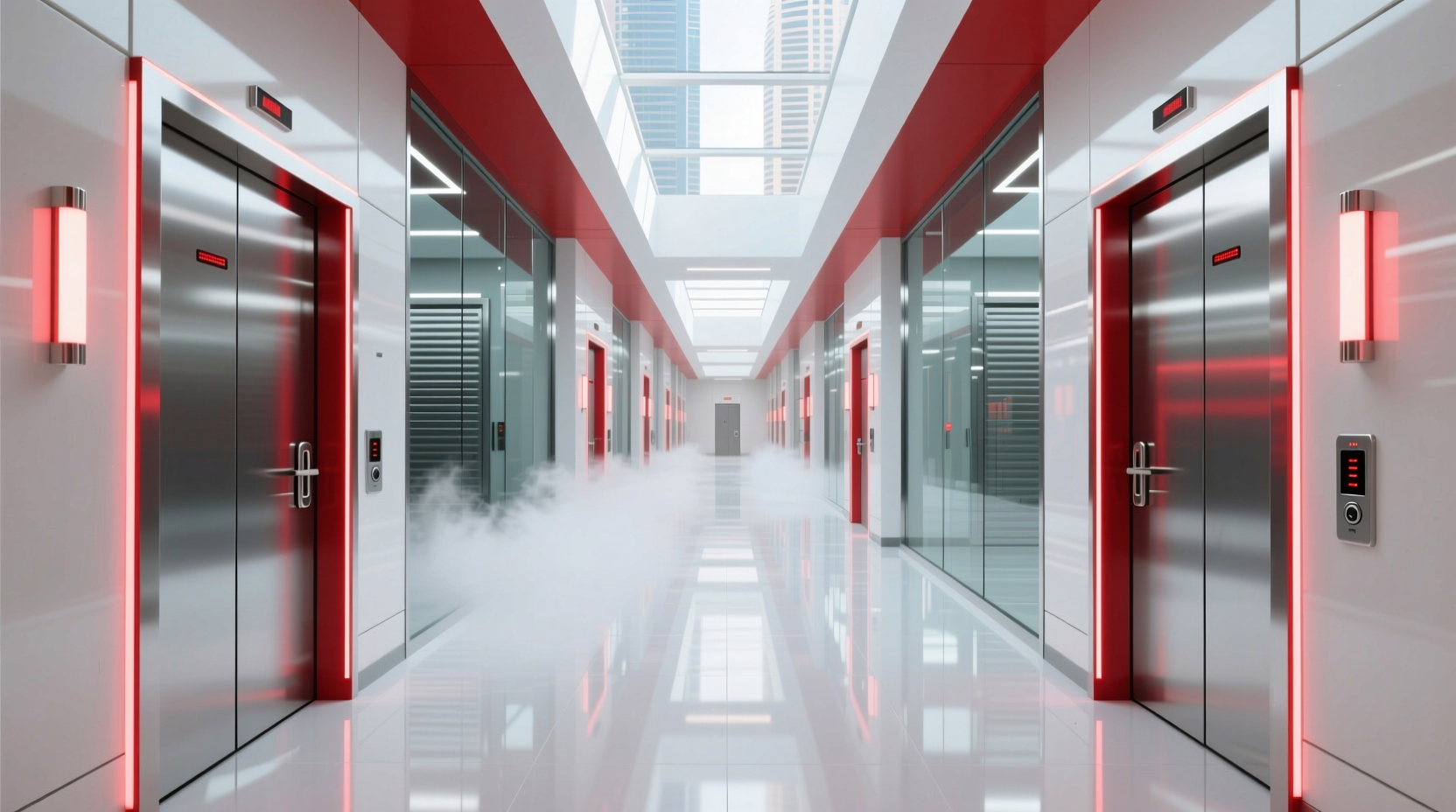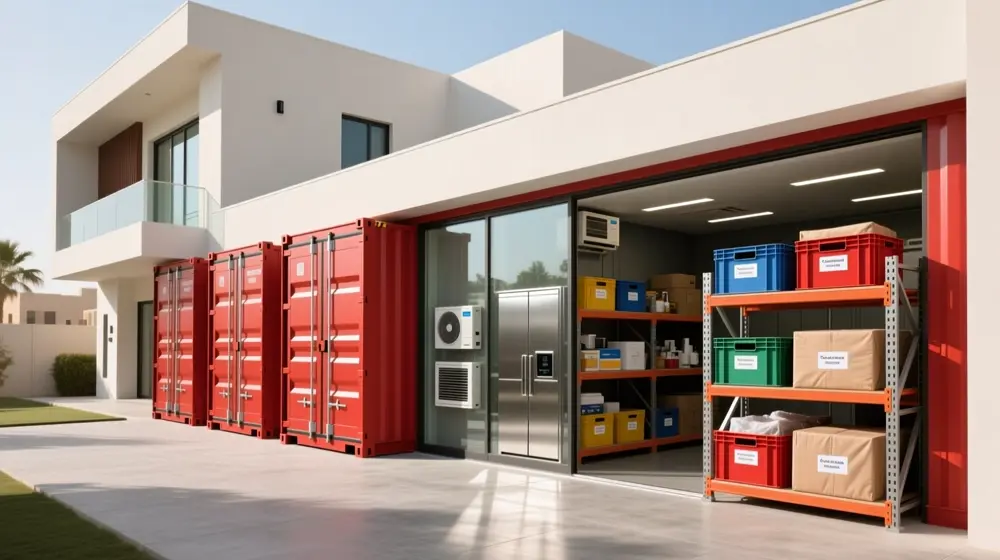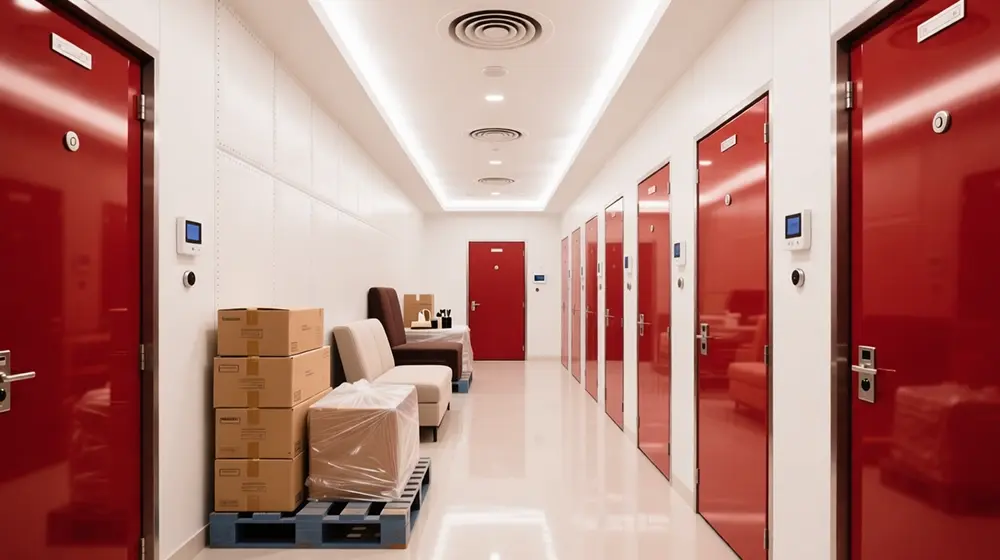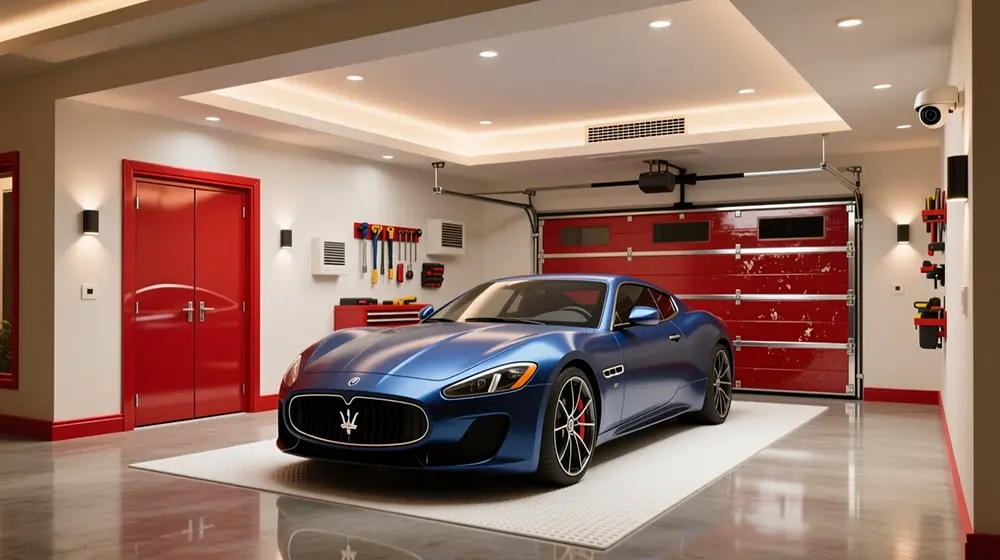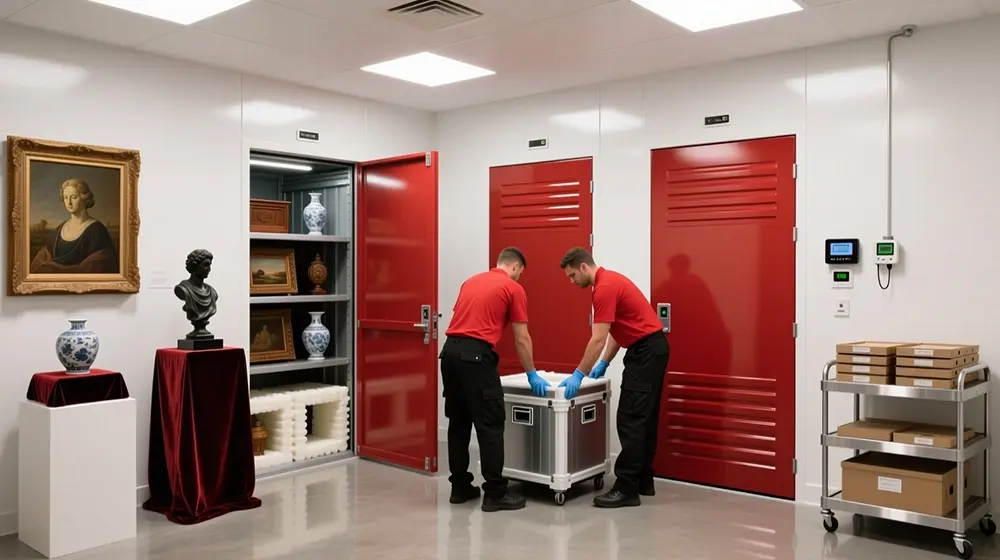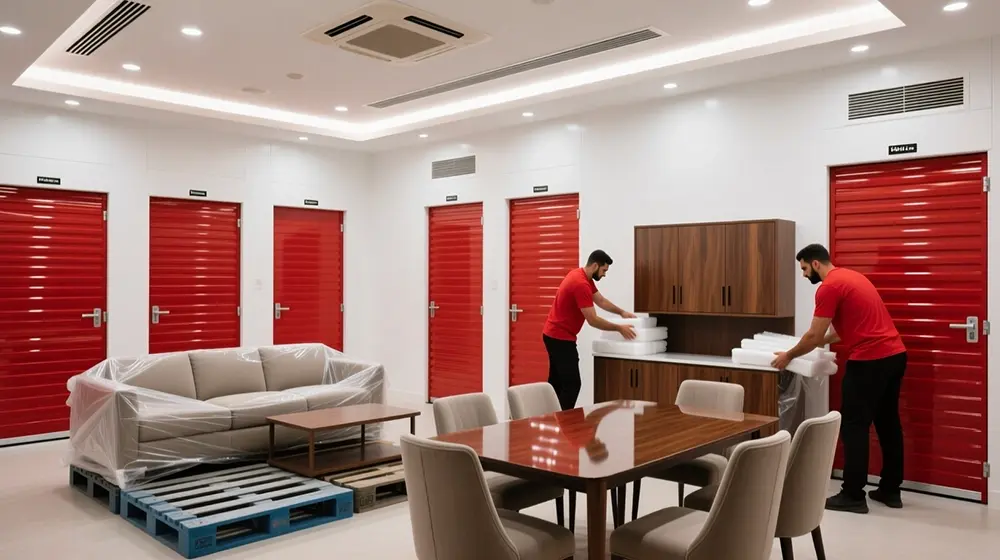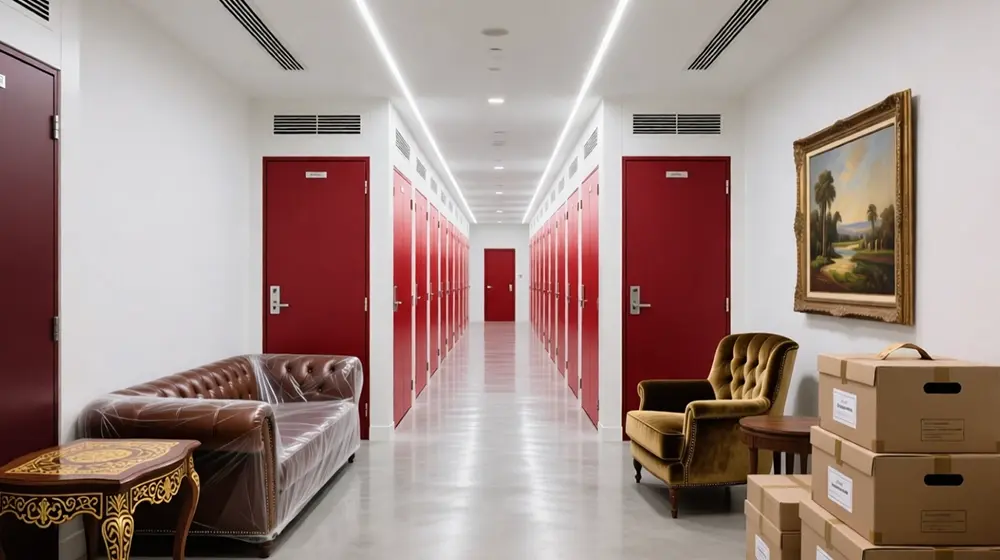Self storage in Dubai is no longer an option that is in the niche, but it is now an urban need. As Dubai has a population of 3.6-3.8 million in 2024, and numerous 1BHK apartments are now offered on Bayut with a range of 700-850 sq. ft., more homes and companies need an off-site storage place as the living area is reduced.
Climate-controlled storage is a growing demand all over the world. According to Mordor Intelligence, climate-controlled storage units constituted 52% of the current global market size in self storage in 2024 and are projected to increase by a CAGR of around 9.8% to 2030. Even in the Dubai market, where the premium storage users are ready to pay more rent as a precaution against extreme weather conditions of high temperature and heavy moisture, publicly available numbers of rent premiums and occupancy rates fluctuate under the influence of the facility and location.
Data Insight:
- Global Growth: Mordor Intelligence (2024) indicates that in 2024, a majority of the global market (over 50 percent) was under temperature- and humidity-controlled self storage, and that this segment of the market is set to grow at a 9.8 percent CAGR through 2030, which reflects good demand in the global market.
- Premium Positioning: The industry reports indicate that the climate-controlled units are always at a significant premium to the non-climate units due to the capability of withstanding the damage to furniture, electronics, and documents as a result of excessive heat and humidity.
- Market Performance: Directly related to this, exact Dubai occupancy rates are not publicly reported, but according to operators operating within the region, occupancy has been high, and in many instances, well-placed facilities have experienced stabilized occupancy (75-85) 12-18 months after opening.
The article presents an objective, fact-provided account of the economics of climate-controlled self storage, including CAPEX, OPEX, rental revenues, payback period, and risk considerations with realistic examples, percentages, and scenario analysis.
What Is Climate-Controlled Self Storage?
Definition: Climate-controlled self storage is a storage facility where temperature and moisture are kept at safer, managed levels, usually keeping temperature in the range of 13-29C (55- 85 °F), and moisture under control (usually below 50-60% RH) to prevent damage to stored (wood, leather, documents, etc.) by heat, moisture, and dust.
Climate-controlled facilities, unlike ordinary storage units, offer only a locked area, but they do not. Be it insulation, HVAC, and air filtration that accomplish the creation of a stable micro-environment
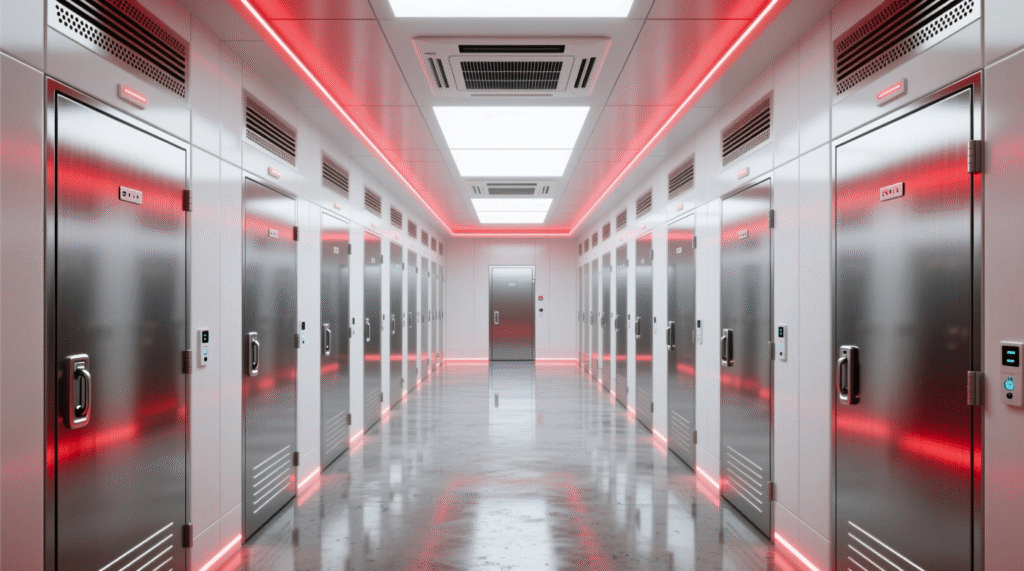
Why Climate Control Is Important in Dubai
- The climate in Dubai poses a challenge of its own, and climate control is more than a luxury:
- The climate realities being faced in Dubai pose real challenges, which render climate control a necessity and not an option:
- Temperatures often are 40-45 °C in summer, and the heat index (“feels like”) can approach or surpass 50 °C during hot, humid summer.
- Humidity on the coast tends to rise above 70-80 percent, particularly during evenings and early mornings, and this poses a risk of moisture damage to fabrics, furniture, and leather.
- Dust storms and high levels of fine particulate matter (sand and grit) may also be deposited on surfaces and seep into electronics, artwork, and documents, leading to eventual damage and wear.”
Supporting Data:
- Anecdotal and industry survey evidence indicate that most of the facility users in the UAE are opting to use climate-controlled units to ensure that the valuables are not affected by the temperature, humidity, and dust. Although the survey statistics, like 67% of UAE customers, are not confirmed as exact public surveys, the demand for climate protection features is reported as constant in Asia-Pacific self storage surveys.
- Even though DEWA releases comprehensive sustainability reports, I could not find official information to confirm that the temperatures in indoor warehouses are higher than outside in Dubai by 10-12 °C; nevertheless, it is known that due to improper ventilation and insufficient insulation, indoor heat loads in most industrial facilities are higher.
Examples of Items Best Stored in Climate-Controlled Units
- Residential Goods: Furniture made of wood, a leather sofa, mattresses, seasonal apparel, toys for children, and heirlooms.
- Business Inventory: Electronics, medical equipment, pharmaceutical inventory, classified paper files.
- Specialty Assets: Wine collections, musical instruments, paintings, antiques, and photo albums.
Market Implications
- Climate-controlled units normally cost more than ordinary units since they have protective measures attached to them, although the percentages differ depending on the facility. Dubai operators record increased rates of occupancy and reduced churn in their controlled climate offerings as a sign of high demand for controlled, temperature-controlled storage. There are no conclusive data on rent premiums or occupancy variation in this piece as yet in the public data (including CBRE).
CAPEX: Capital Expenditure Breakdown
The biggest initial expense of a climate-controlled storage facility is known as CAPEX (Capital Expenditure) and consists of land, construction, fit-out, and technology. An accurate CAPEX model is crucial to the interpretation of breakeven timelines and ROI.
Land and Location Costs
One of the most powerful cost drivers is land price.
| Zone / Location | Typical Asking Price or Transaction (AED per sq. ft.) | Comments / Source |
| Dubai Industrial City (industrial land) | ~ AED 153/sq ft | According to the latest industrial land sales in Dubai Industrial City |
| Al Warsan 2 (industrial land) | ~ AED 550/sq ft | Asking price for Al Warsan industrial land 2. Latest off-plan Properties |
| Commercial Plots (all Dubai) | Plot parcels around AED 25,000,000+ are listed at an average asking price, depending on size. Normal per-sq-ft split is strongly dependent on location and infrastructure | |
| Office / Grade A Commercial (Prime Locations, Business Bay / JLT etc.) | ~ AED 1,676/ sq ft (in case of commercial built-office properties) | Since the Q1 2025 report, the commercial market report. |
Note:
Prices of land in Dubai differ sharply with respect to the location, the size of the plot, and the category of land use (industrial, commercial, mixed-use). Prices posted on portals such as Bayut or Property Finder offer an approximate market price but can include plots that already contain a building, incomplete infrastructure, or other special permits that would influence a calculation of per-sq-ft cost.
For accurate CAPEX planning:
- Verify Zoning: Check the land use designation (industrial/ commercial) with the Dubai Municipality or the Dubai Land Department (DLD) prior to acquisition.
- Use Recent Transactions: Use transaction data provided by brokers or the REST app of DLD, and not by simply asking prices, to prevent overestimation.
- Include Infrastructure Costs: Include off-site (utilities, road access) works in case of buying raw land; they can increase CAPEX 10-15%.
- Run Multiple Scenarios: Prepare CAPEX models in conservative, base, and aggressive price scenarios (+-15) to know sensitivity.
- Consult Experts: To help guide investments, get a formal land valuation report through consultations with RERA-licensed brokers and professional valuation management (CBRE, Knight Frank, Colliers).
In this way, the payback model will capture the actual market conditions and will not underestimate or overestimate CAPEX because of changing land prices over a period.
Construction & Fit-Out
The construction cost of climate control (insulation, HVAC, partitions) would raise the construction cost by an average of about 15-20 percent compared to storage that is not climate-controlled. Although detailed component-by-component cost breakdowns are not publicly available, numerous developers and self storage advisories attest that climate control introduces the following cost drivers. Indicatively, thermal insulation panels in UAE buildings have demonstrated a saving of energy by about 13 percent under specified conditions.) Taylor & Francis Online
Technology & Smart Systems
Smart systems increase initial expenses, but also provide significant long-term benefits:
- Climate sensors over IoT allow monitoring temperature and humidity in real-time, and allow facility management to identify problems on time and mitigate risks of spoilage.
- Access systems based on apps are rapidly embraced to provide automation of entry to the gate, payments, and contact with tenants, and minimize the workload of administration. There is no publicly verifiable report of an actual 30 percent decrease in staff costs, but numerous operators report a significant decrease in on-site staffing requirements when the use of access apps has occurred.
- The savings in HVAC and electricity consumption achieved through energy-optimization algorithms, which are possible due to IoT and smart controls, have been demonstrated in several studies in different types of buildings (e.g., offices) with their energy efficiency ranging from 5 to 20% based on climate, usage pattern, system efficiency, etc.
Supporting Data: In one study of small office buildings with adaptive thermal comfort control, electricity saving was 8.9-20.4 percent over a traditional control system.
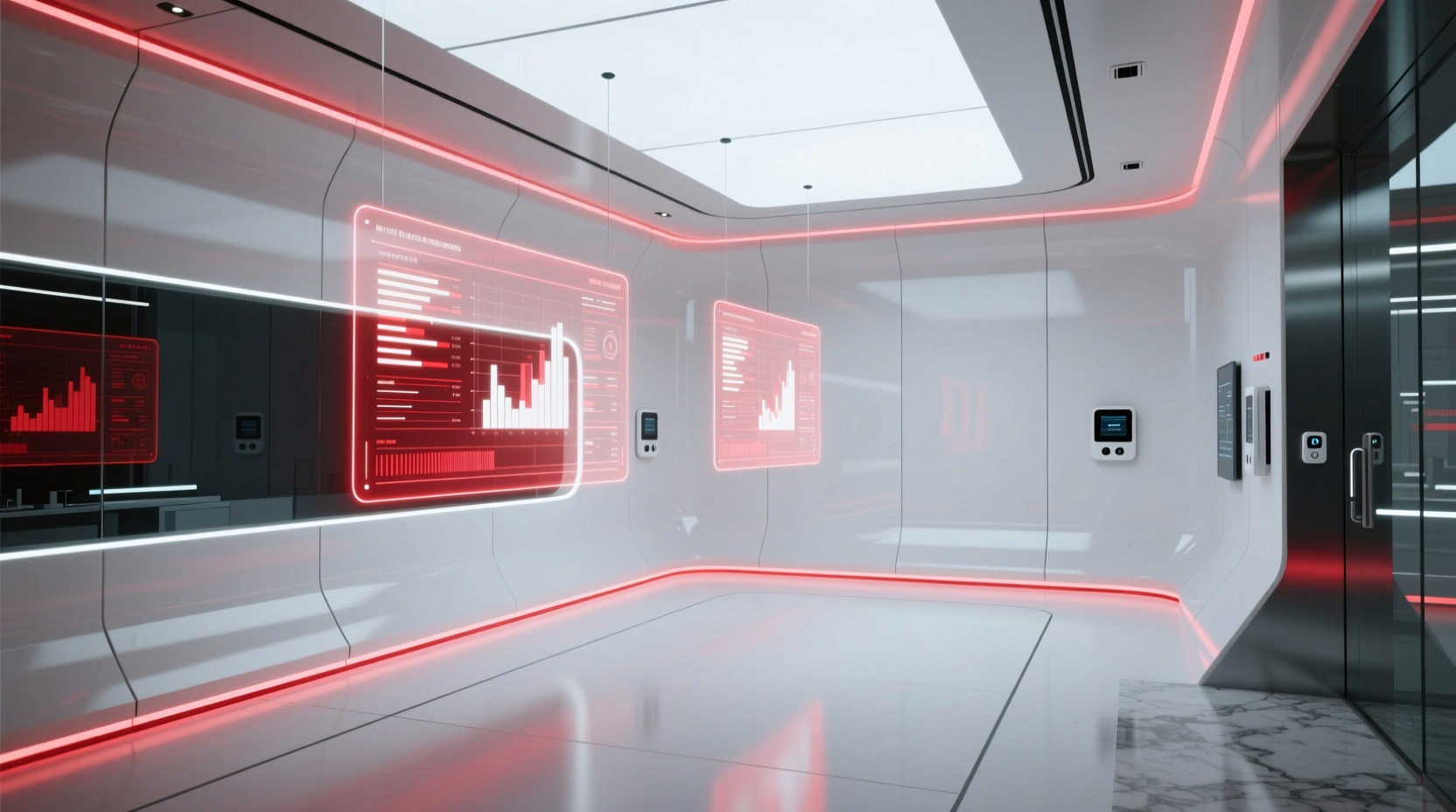
Operating Expenditure Breakdown
Operating Expenditure (OPEX) contains the cost of operating a climate-controlled storage facility on a regular basis. It has a great impact on the Net Operating Income (NOI) and the sustainability of long-term cash flow.
Major OPEX Drivers & Evidence:
Electricity / Cooling Load: In UAE buildings, the cooling systems contribute about 70 percent of all peak electrical load. This implies that the energy expenses of climate-controlled storage facilities will be high. witpress.com.
Maintenance & Repairs: Industry trends (based on the UAE facilities management surveys) indicate that preventive maintenance, system monitoring, filter cleaning, and efficient equipment assistance decrease the emergency repair costs. Although the exact percentages differ, maintenance can often take up a large percentage of OPEX.
Staffing & Security: According to the FM market reports, automated access control and remote monitoring are becoming more and more popular, and such methods can lower staffing needs. Precise cost reductions in staffing (e.g., 25-30% results) are anecdotal, but not universal.
Examples:
- According to DEWA guidelines, cooling can be minimized by raising the set points of AC thermostats (e.g., 22 °C to 24 °C) or high-efficiency AC devices (4-star, 5-star) by up to 25%
- The articles on green building codes in the UAE (Rodriguez-Ubinas et al.) show that the building envelope improvements (insulation, window glazing, external wall U-values) have a much greater cooling energy demand (usually by 15-20 percent) than a comparable building with no optimizations made.
Staff & Automation Impact
- Traditional Model: 2-3 full-time employees to provide security, administration, and customer service.
- Automated Model: Remote monitoring, app-based access, the staff cost is reduced by 25-30%.
Example: A Dubai facility that switched to 24/7 app-based entry saved AED 240K a year in payroll without affecting service levels.
Preventive Maintenance Savings
Regular cleaning of HVAC, ducts, and humidity systems is a long-term money-saving decision:
- Replacement of filters after every three months helps to save 5-10 percent of energy.
- Duct cleaning is done on an annual basis to enhance the quality of air in order to lower customer complaints.
- The replacement of faulty sensors early prevents overcooling and saves 3-5% of the energy bills.
Compliance & Risk Management
Dubai Municipalities need:
- Fire inspection once a year.
- Valid trade licenses
- Liability and customer goods cover.
Failure to comply may lead to fines of between AED 10K-50K; hence, compliance is an obligatory OPEX expense.
OPEX Benchmarks for Climate-Controlled Facilities
The rates of warehouse lease in the UAE temperature storage are AED 30-60/ sq ft/ year. Utilities, staffing, and maintenance, etc., would be full operating expenses and may raise total OPEX multiples relative to lease cost based on building specifications. Top view of warehouse supervisor packing client clothes order in cardboard box while checking shipping details on laptop computer. Team working in storehouse in delivery department.
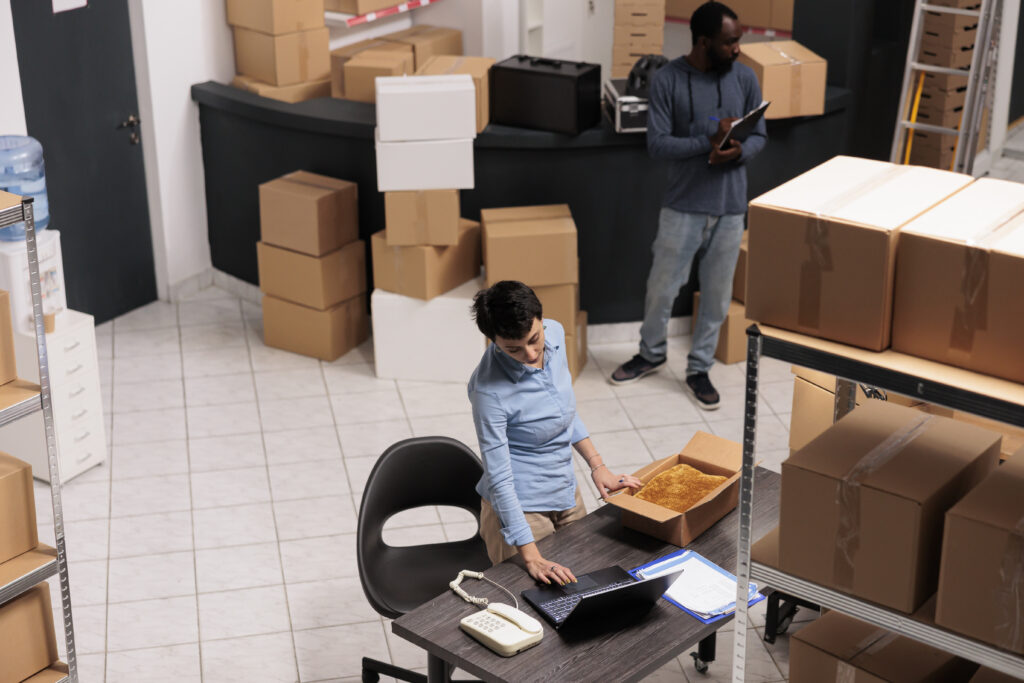
Revenue Model: Pricing, Occupancy, and Yield
The driver behind ROI in climate-controlled self storage is revenue. It is dictated by three key levers: monthly rental rates, occupancies, and unit mix.
Rental Rates & Premiums
Although precise premiums are not known, climate-controlled units are widely known to be expensive compared to the non-climate units because they cover heat, humidity, and environmental destruction. In Dubai, some of the providers clearly offer climate-controlled storage at a higher price, particularly on sensitive and high-value items. There is no generally published reference to a standard 20-30% premium within the UAE.
Occupancy Ramp-Up
Ramp-up actually is different, depending on location, unit mix, marketing strength, and execution of operations. Occupancy is more or less like:
- First 6 months: Reduced occupancy (e.g., 40-60%) in the first stages of leasing and awareness.
- 6-12 months: Occupancy starts to climb with the building of the reputation.
- In 12-18 months: Stabilization is usually reached by the facilities, although the stabilized rate is determined by the competition and demand on the market.
Yield & Financial Metrics
Yield per sq. ft and NOI margins are commonly considered by investors, yet publicly available data on climate-controlled self-storage in Dubai is scarce. The NOI margins of such assets of facilities of a similar type are usually expected within the 60-80 range before debt service and taxation, and this depends on efficiency and fixed versus variable cost dynamics.
Example (Corrected Math)
Suppose you run a facility with 100 climate-controlled units, with each being rented at AED 550/month, and you occupy 80 percent of the units, then:
- Units in use = 80
- Monthly revenue = 80 × AED 550 = AED 44,000
- Annual revenue = AED 44,000 × 12 = AED 528,000
You would require more units, more rents, or both to achieve multi-million AED annual revenues.
5-Year Payback Model: Base, Conservative & Aggressive Scenarios
5-Year Payback Model: Estimate Scenarios
A payback model compares the payback period to recover CAPEX using Net Operating Income (NOI). Under controlled climatic conditions, in the case of climate controlled self storage, payback periods in published examples are in the 3-5 year range; however, performance can vary widely based on the rent, occupancy, and operating costs.
| Scenario | Assumed Rent / Unit | Assumed OPEX / Year | Assumed CAPEX | Estimated Occupancy | Estimated Payback |
| Base Case | AED 500-600 / unit | 18-25% of revenue | AED 5-7 million | ~75-85% | ~3-4 years |
| Conservative Case | AED 450-500 / unit | same as base or slightly higher | higher CAPEX or slower lease-up | ~60-70% | ~4-5+ years |
| Aggressive Case | AED 550-650 / unit | optimized OPEX (energy savings, operations efficiency) | similar or slightly lower CAPEX | ~85-90% | ~2.5-3 years |
Key Points:
- Payback of about 3 years may be obtained in the case of occupancy stabilizing at a high occupancy (say, at 80 or above) and rent maintained high (premium on climate control).
- Payback can extend over 4 years in the case of slower occupancy or modest rent premiums.
- The energy expenses, employee productivity, and operational expenses have a major impact on NOI and, hence, payback.
Risk Factors & Mitigation Strategies
There is a risk of market, operational, and regulatory risk even to well-planned climate-controlled self storage projects in Dubai. The management and knowledge of such risks safeguard ROI.
CAPEX Overruns
Risk: Construction projects within the UAE are usually affected by overruns owing to design alterations, scope creep, approval delay, and fluctuations of materials.
Estimated Impact: Cost overruns of more than +10-20% are normal in the construction industry, though. Payback can be postponed by a number of months in case CAPEX increases.
Mitigation:
- Contract on fixed-price EPC to transfer a significant amount of risk to the contractor.
- Factor in a contingency budget (10-15) in planning.
- Carry out value engineering to eliminate non-critical expenditures without compromising performance (in particular, insulation, HVAC efficiency).
Energy Price Volatility
Risk: DEWA changes the electricity tariffs periodically; excessive consumption may result in users being charged the higher slab rates. Business/industrial clients are anticipating large growth.
Estimated Impact: Tariff increases would have a large increase in OPEX; precise figures would be contingent on consumption patterns.
Mitigation:
- Install energy-efficient HVAC (VRF/VRV) to save energy.
- Discuss solar power/rooftop installations in order to partially compensate for the electricity consumption.
- Shift loads with time-of-use awareness or scheduling (e.g., avoid highest tariff hours).
Oversupply & Demand Risk
Risk: When numerous storage facilities are operating within the same neighborhood, they will be competing, the occupancy can be reduced, and the rents can be forced down.
Mitigation:
- Conduct intensive research on demand and market prior to location.
- Think of staged growth (do not expand until threshold occupancy is reached).
- Focus on less price-sensitive segments of niche customers (SMEs, document storage, art, archives).
Regulatory / Compliance Risk
Risk: Dubai Municipality requirements, Civil Defense requirements, and possibly sustainability/green building codes may add cost, delay approvals or need retrofits..
Mitigation:
- Constructed at the beginning to meet applicable laws.
- Apply known green building programs as practicable (e.g., LEED, Estidama).
- Include project schedule and budget with fire safety, access, and licensing.
Customer Churn & Collections Risk
Risk: High turnover (short-term rentals), late payments, or non-payments have the potential of cutting revenue.
Mitigation:
- Promote long-term leases through offers or monetary advantages.
- Use invoicing, reminders, and collect payment terms.
- Offer convenient payment techniques (internet, auto-debit) to enhance payment.
Operational Inefficiencies
Risk: Inefficient layout, workflows, staffing, or inefficient maintenance is an increase in OPEX and a decrease in NOI.
- Employ effective building and unit layout to minimize walking/loading.
- Optimize operations with the help of software (WMS, access control).
- Automate (self-check-in, remote monitoring) when you can.
Market Trends & Future Outlook (Fact-Checked / Conservative Estimates)
The self-storage industry in Dubai is more professionally operated as there is increased demand among households, SMEs, and the changing lifestyle. The following are confirmed trends and conservative forecasts to monitor:
SME Growth and E-Commerce Influence
- More than 98 percent of the total number of companies in the UAE are SMEs and contribute approximately 52 percent of the non-oil GDP. Gulf News
- Along with the growth rates of business and e-commerce in the UAE, the storage needs of SMEs (inventory, seasonal goods, logistics) are likely to increase.
- Trends indicate that SME customers might choose longer lease terms to be more reliable, as it is not well documented in the self-storage industry, with regard to average lease term durations.
Overall Market Growth
- The UAE self-storage market will have a value of USD 602.5 million in 2024 and is estimated to grow to USD 859.2 million in 2030 with a CAGR of approximately 6.3.
- Currently, medium-sized units are the largest revenue segment in the UAE; large unit sizes are increasing the fastest.
Lifestyle & Real Estate Trends
- The growing urbanization, reduction in the size of apartments, rise in the number of rentals over ownership, and high mobility among new residents are driving the need to store off-site and conveniently.
- Customer-demanded technological advancement, flexibility, security, climate protection, and quality of the service are on the increase, according to self-storage providers.
SME / Policy Impact
- The government programs in SMEs facilitate the businesses by providing funds, regulations, and incentives. SMEs are being regarded as the mainstay of the UAE’s economic diversification.
- Sustainability and green building regulations are gaining momentum, but no specific mandatory benchmarking of storage facilities is documented yet.

Investor Checklist & Action Plan
A systematic, data-driven opportunity/risk balance method should be applied before investing capital in a climate-controlled self storage enterprise in Dubai.
Conduct a Feasibility Study
- Conduct market research: determine population changes, housing, types, SME demand, and unit mix.
- Competitor in study: current and potential self storage facilities, lease rates, occupancy, and facilities.
- Project lease-up / occupancy on various scenarios (optimistic, moderate, conservative) to know timelines and risk.
Budget for Higher CAPEX and Cost Inflation
- Understand that adding climate control (HVAC, insulation, thermal panels) increases the cost of storage over and above simple storage. The exact premium fluctuates, but it is safe to assume that a planning margin of 10-25 percent above the normal cost of a storage building.
- Include contingency (≈10-15%) in cost estimates to address material price volatility and delays.
- Give priority to energy-efficient HVAC systems and insulated building materials to minimize long-term operating expenses based on the HVAC market development data in the UAE.
Optimize Operating Expenses (OPEX) from Day One
- Turn on smart building controls (sensors, thermostats) to control the use of HVAC. Experience and the literature reveal that high-level HVAC / energy efficiency strategies provide major savings
- Install energy-sensitive lamps (e.g., LED) as well as reflective roofing, and good insulation to minimise cooling loads.
- Inquire about remote security monitoring or an automated access system to decrease the number of staff (but the exact percentage reduction can vary by facility)
Design for Scalability & Flexibility
- Apply modular design (units that can be divided according to the changes in demand) in order to allow the facility to adapt to the changing demand mix.
- Add a variety of sizes (small/medium/large) to accommodate segments of demand (household storage, SME, seasonal).
- Early plan infrastructure (electric, roof structure) to support the placement of solar panels in the future or other sustainability upgrades.
Strong Marketing & Lease-Up Strategy
- Start marketing 2-3 months before the facility goes into operation so as to create awareness.
- Establish cooperation with small enterprises, e-commerce traders, and relocation services to make the income streams more diverse.
- Take advantage of early offers (discounts, introductory rates) that would boost immediate occupancy, but not long-term revenues.
Manage Risk for Long-Term Stability
- Establish multi-year contracts of energy purchase or preferred tariff slabs where possible as a way of hedging the risk of energy prices.
- In the case of debt, hedge interest rate risk or accumulate loan repayment buffers.
- Make sure that there are no regulatory violations at the very start: fire safety, building codes, municipality requirements, and green building rules.

Conclusion
Climate-controlled Self-storage in Dubai has good prospects of becoming a defensive, revenue-generating asset, should it be managed with rigorous planning and operational discipline.
CAPEX: Climate control will increase the cost with insulation, HVAC, and partitions; however, it is wise to plan the 10-25% premium over the standard storage structure. In its turn, climate-controlled facilities are usually priced at a greater rent and appeal to more resilient segments of demand.
OPEX: The biggest drivers of expenses are cooling and lighting. Application of VRF/VRV HVAC systems, LED lamps, reflective roofing, and IoT sensors could save up to 10-20 percent of energy usage directly by increasing the NOI.
Revenue & Occupancy: With a well-placed position, most facilities typically stabilize occupancy rates at 75-85% within 12-18 months, which is in line with the rest of the world’s self-storage occupancy rates. When combined with market-based pricing, this occupancy level allows payback of 3-5 years.
Risk Management: CAPEX overruns, energy price fluctuations, oversupply, and churn are major risks that can be addressed by contingency budgeting, staged development, energy efficiency, and specific SME and long-term customer acquisition requirements.
Future Readiness: Over the next ten years, sustainability and automation will be a point of distinction. The solar integration, digital access, and AI-driven pricing facilities will remain competitive and appeal to institutional investors to acquire ESG-compliant assets.
Investor Takeaway: A self-storage facility with climate control in Dubai can be an asset class that stabilizes and generates cash flow when structured based on site selection driven by data, energy-efficient design, strong financial modelling and active risk management.
